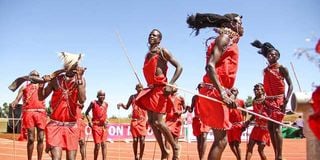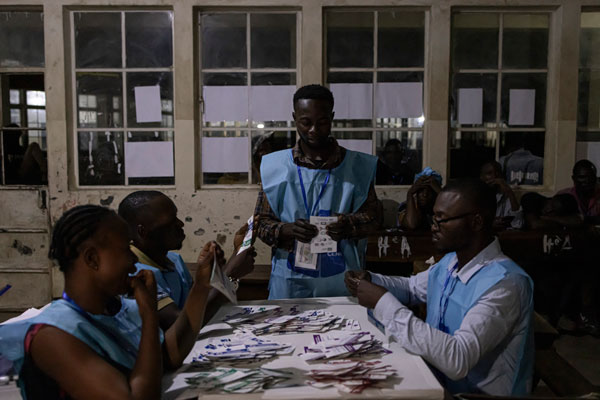
Maasai traditional dancers entertain guests at a past public event.
I arrived at the animal market in Suswa, Narok County, on Wednesday shortly after sunrise. Streams of cattle were converging on the market, but none was in the grounds yet.
However, there was a pen packed with donkeys, that pitiful, long-suffering, unloved beast.
The whole day the donkeys provided comic relief, the men would point with their chins to the pen and say “Soup” and break into uproarious laughter.
Apparently, the donkeys were gathered for a buyer who slaughters them and exports the meat to China.
“The Chinese will eat anything,” someone would say and another would add “hata nywele (even fur)” and there would be even more laughter.
Some chase sunsets, others climb mountains, I go to markets. This time I’m doing Maasailand; I have done Bisil and Suswa, then I’ll go to Mulot, Ntulele and Voi, God willing.
At Bisil last market I didn’t buy a single animal, but I had a lovely time in the market and I indulged my curiosity about Maasai herbs. Rural Maasai are wonderfully friendly and charismatic.
The women, especially the older ones, are delicately naughty and flirtatious. I spent lots of time fighting off their attempts to sell me aphrodisiacs.
They would look at me from under their lashes, fighting to suppress broad grins and say: “Nigo na ile ya waasee (I have the medicine for old men)”. “Bado kidogo,” I’d say and a whole riot of challenges would ensue.
The Maasai have very good animals – the brown Sahiwal cross-breeds are particularly popular – and not by accident. Even the most pedestrian of men knows how to take care of cattle; to wash, feed, treat and manage them, it is natural to them.
They spent lots of time teaching me how to tell an animal’s breed from the ears and estimate their age from the state of their horns. In general, the higher the Sahiwal genetic content in mixed stock the better.
Sahiwal is Asian, not indigenous, but it combines with local genes to make great cattle. Local breeds are hardy, but they have slow growth and their eventual size is relatively small. At Suswa, fully grown Sahiwal service bulls paced restlessly like Goliaths in a market of Davids.
I fitted right in, having grown up in this culture of bands of young men spending their lives together. The uneducated Maasai lad, I discovered, divides the universe of men into two: Maasai and Kikuyu.
They are notorious code switchers, speaking Kiswahili to you if they are addressing you and switching to Maa when addressing another Moran, leaving you out. In their general perspective Maasai are good, Kikuyu are clueless. And it is true: from judging, managing and general knowledge of animal keeping, they know a lot more than anyone else.
Precious culture
In town I saw a different kind of Maasai: more Westernised, fatter, richer. Their manner is imperious and discriminative. I suppose this is the improved Lumpen that fired William Ole Ntimama’s massacres of the Kikuyu in Enoosupukia and other places. Seeing how much Maasai trust other Maasai, it would not have been too difficult to incite warriors and fire them up to violence against “foreigners”.
The tendency of the African elite to bring out the worst in us is the reason why we are still colonised.
In Maasailand, you will notice that the boda boda passenger carries two sticks, the “fimbo” that a Maasai man will not leave the house without. The passenger will hold his own stick and that of the rider. The stick is useful with animals, for guiding, probing and often smacking them. But also under every man’s armpit is a simi, in a kind of underarm holster, or hanging on their belt. Some are long, others are short, depending on how discreet one wants to be. I spent a long time polling these men to see if any one of them had ever used their sword. They said no but of course these are genetically men of war. And men of war never brag about combat.
These Maasai men are lovely people, full of fun and laughter and a great conquering attitude. Their lifestyle, wandering with cattle out in the wild is great, if it is combined with a more modern existence of school and engagement with the modern economy. The Maasai are not dumb at all, that’s a foolish urban myth, their minds are strategic and aggressive: when they are playing you, they don’t rely on subtlety, they are audacious, relentless and utterly ruthless. Their loyalty to each other is a great asset.
The way to preserve this precious culture is not a full-scale invasion and take-over of their lands, forcing them into subsistence agriculture or into urban centres, it is to protect their lands so that animals can be moved for pasture, the breeds are improved, local knowledge is enriched, warriors can continue to be warriors, not fat, improved lumpen. New Suswa declaration: Respect, preserve indigenous lifestyles.










